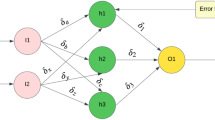Abstract
Cloud computing is one of the most attractive cost effective technologies for provisioning information technology (IT) resources to common IT consumers. These resources are provided as service through internet in pay per usage manner, which are mainly classified into application, platform and infrastructure. Cloud provides its services through data centers that possess high configuration servers. The conservation of data centers energy give benefits to both cloud providers and consumers in terms of service time and cost. One of the fundamental services of cloud is infrastructure as a service that provides virtual machines (VMs) as a computing resource to consumers. The VMs are created in data center servers as the machine instances, which could work as a dedicated computer system for consumers. As cloud provides the feature of elasticity, the consumers can change their resource demand during service. This characteristics leads VMs migration is unavoidable in cloud environment. The increased down time of VMs in migration affects the efficiency of cloud service. The minimization of VMs migration reduces the processing time that ultimately saves the energy of data centers. The proposed methodology in this work utilizes genetically weight optimized artificial neural network to predict the near future availability of data center servers. Based on the future availability of resources the VMs management activities are performed. The implementation results demonstrated that the proposed methodology significantly reduces the processing time of data centers and the response time of customer applications by minimizing VMs migration.






Similar content being viewed by others
References
Subashini S, Kavitha V (2011) A survey on security issues in service delivery models of cloud computing. J Netw Comput Appl 3(1):1–11
Rania FE (2014) A literature review on cloud computing adoption issues in enterprises. Creat Value for All Through IT 429:214–242. doi:10.1007/978-3-662-43459-8_14
Micheal B (2009) In cloud shall we trust? IEEE Secur Priv 7(5):3–6
Cardoso A, Simoes P (2012) Cloud computing: concepts, technologies and challenges. Virtual Netw Organ Emerg Technol Tools 248:127–136. doi:10.1007/978-3-642-31800-9_14
Qiao B, Zhang Z, Yanpeng G, Yutong L, Yuhai Z, Guoren W (2013) Weight based live migration of virtual machines. Trends Appl Knowl Discov Min 867:543–554. doi:10.1007/978-3-642-40319-4_47
Tushar D, Jignesh P (2013) A survey of various load balancing techniques and challenges in cloud computing. Int J Sci Technol Res 2(11):158–161
Jasmin J, Bhupendra V (2012) Efficient VM load balancing algorithm for a cloud computing environment. Int J Comput Sci Eng 4(9):1658–1663
Ray S, Ajantha DS (2012) Execution analysis of load balancing algorithms in cloud computing environment. Int J Cloud Comput 2(5). doi:10.5121/ijccsa.2012.2501
Han H, Jinseak K, Sungyong P (2009) A QoS based migration scheme for virtual machine in data centers environments. Manag Enabl Future Internet Chang Bus N Comput Serv 5787:544–547. doi:10.1007/978-3-642-04492-2_73
Willium V, Broberg J, Venugopal S, Buyya R (2009) Cost of virtual machine live migration in cloud: a performance evaluation. Cloud Comput 5931:254-265. doi:10.1007/978-3-642-10665-1_23
Hines R, Umesh D, Kartik G (2009) Post copy live migration of virtual machines. ACM SIGOPS Oper Syst Rev 43(3):14–26
Lee JH, HeonChang Y, JoonMin G (2011) A virtual machine migration management for multiple data centers based cloud environments. Adv Comput Sci Inf Technol 195:198–205. doi:10.1007/978-3-642-24267-0_24
Yang CT, Cheng H, Huang K (2011) A dynamic resource allocation model for virtual machine management on cloud. Grid Distrib Comput 261:581–590
Min C, Inhyeo K, Taehyoung K, Young LK (2012) VMMB: virtual machine memory balancing for unmodified operating systems. J Grid Comput 10(1):69–84
Lu P, Barbalance A, Palmieri R, Binoy R (2014) Adaptive live migration to improve load balancing in virtual machine environment. In: Euro-Par 2013: parallel processing workshops 8374:116-125. doi:10.1007/978-3-642-54420-0_12
Che ZG, Chiang TA, Che ZH (2010) Feed-forward neural networks training: a comparison between genetic algorithm and back-propagation learning algorithm. Int J Innov Comput Inf Control 7(10):5839–5850
Truong VTD, Yukinori S, Yasushi I (2010) Improving accuracy of host load predictions on computing grids by artificial neural network. Int J Parallel Emerg Distrib Syst 26(4):275–290
Liang H, Che XL, Zheng SQ (2012) Online system for grid resource monitoring and machine learning-based prediction. IEEE Trans Parallel Distrib Syst 23(1):134–145
Sheikh MH, Hauke S, Ries S, Muhlhauser M (2012) Trust as a facilitator in cloud computing: a survey. J Cloud Comput 9. doi:10.1186/2192-113X-1_19
Mahalee HS, Kaveri PR, Chavan V (2013) Load Balancing On Cloud Data Centers. International Journal of Advanced Research in Computer Science and Software Engineering 3(1):1–4
Acknowledgments
This research work has been supported by DST-SERB-(INDIA) Fast Track Scheme for Young Scientist /F/0590/2012-13 dated. 09.05.2012 as required.
Author information
Authors and Affiliations
Corresponding author
Rights and permissions
About this article
Cite this article
Radhakrishnan, A., Kavitha, V. Energy conservation in cloud data centers by minimizing virtual machines migration through artificial neural network. Computing 98, 1185–1202 (2016). https://doi.org/10.1007/s00607-016-0499-4
Received:
Accepted:
Published:
Issue Date:
DOI: https://doi.org/10.1007/s00607-016-0499-4
Keywords
- Cloud computing
- Virtual machines
- Infrastructure as a service
- Artificial neural network
- Genetic algorithm




